Management Accounting Report: Cost Analysis for Jeffrey & Sons Ltd
VerifiedAdded on 2020/01/07
|20
|4687
|70
Report
AI Summary
This report provides a comprehensive analysis of management accounting principles, focusing on a case study of Jeffrey & Sons Ltd. It begins by classifying different types of costs and calculating unit and total job costs using job costing methods. The report then calculates the cost of a product, 'Exquisite,' using various allocation techniques and analyzes the cost data. It further includes the preparation and analysis of a cost report for September, along with the use of performance indicators to identify areas for improvement. The report also delves into budgeting processes, including production, purchase, and cash budgets. Finally, it covers the computation and analysis of variances, culminating in an operating statement and a variance analysis report, providing recommendations for cost reduction and value enhancement.
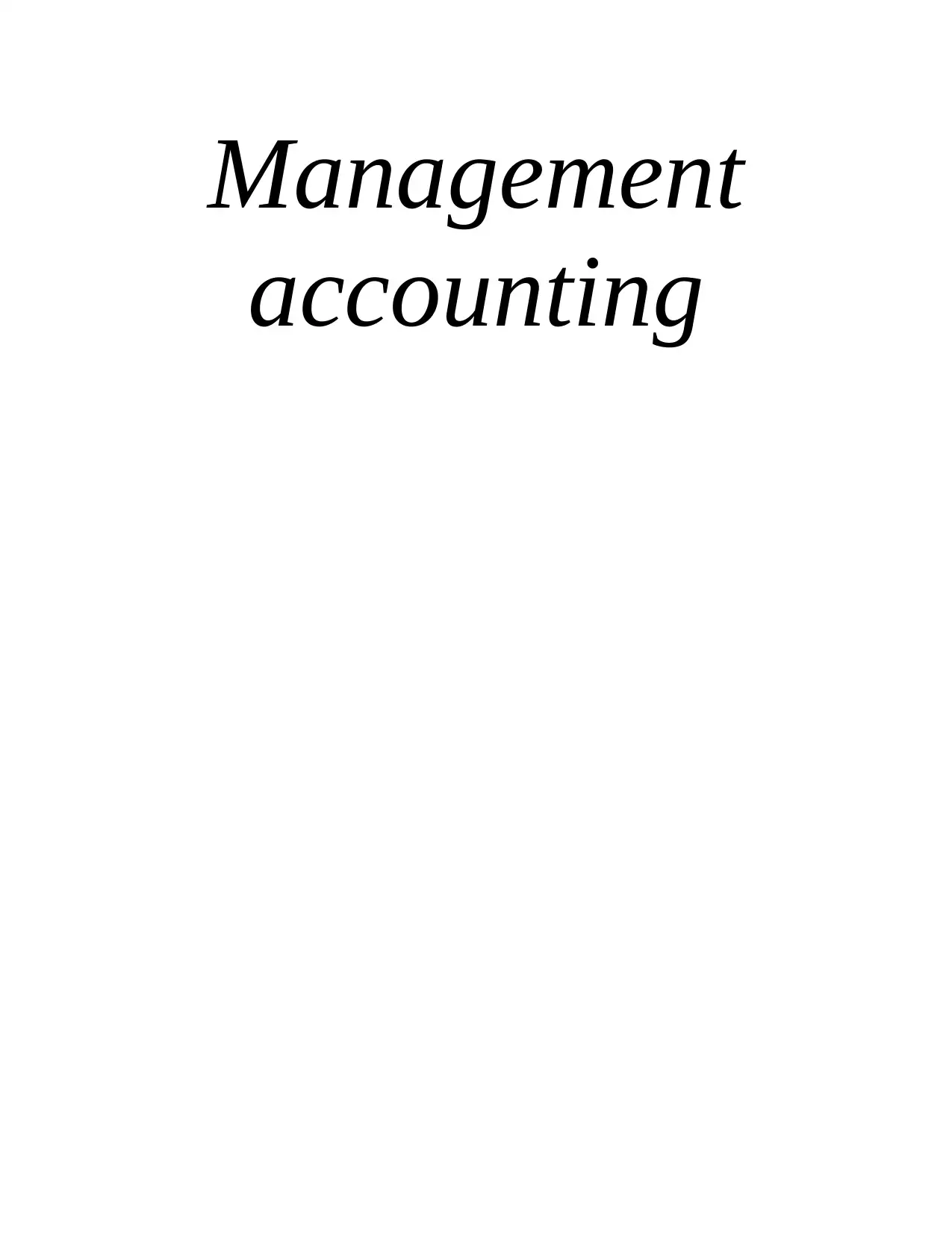
Management
accounting
accounting
Paraphrase This Document
Need a fresh take? Get an instant paraphrase of this document with our AI Paraphraser

TABLE OF CONTENTS
Introduction......................................................................................................................................3
Task 1...............................................................................................................................................3
1.1 Classification of different types of cost.................................................................................3
1.2 Computation of unit cost and total job cost for Job 444........................................................4
1.3 Calculation of the cost of Exquisite using appropriate techniques........................................4
1.4 Analysis of cost data of exquisite using appropriate techniques...........................................8
Task 2...............................................................................................................................................8
2.1 Preparation and analysis of the cost report for the month of September...............................8
2.2 Use of several performance indicators in order to identify area for further improvement. .10
2.3 Recommendations for reduction of cost and enhancement of value and quality................10
Task 3.............................................................................................................................................11
3.1 Purpose and nature of budgeting process............................................................................11
3.2 Selection of appropriable budgeting methods in accordance with the needs of organization
...................................................................................................................................................11
3.3 Production and purchase budget..........................................................................................11
3.4 Preparation of cash budget...................................................................................................12
Task 4.............................................................................................................................................14
4.1Computation and analysis of variances................................................................................14
4.2 Operating statement for reconciliation of budgeted and actual results................................16
4.3 Variance analysis report.......................................................................................................16
Conclusion.....................................................................................................................................17
References......................................................................................................................................18
2
Introduction......................................................................................................................................3
Task 1...............................................................................................................................................3
1.1 Classification of different types of cost.................................................................................3
1.2 Computation of unit cost and total job cost for Job 444........................................................4
1.3 Calculation of the cost of Exquisite using appropriate techniques........................................4
1.4 Analysis of cost data of exquisite using appropriate techniques...........................................8
Task 2...............................................................................................................................................8
2.1 Preparation and analysis of the cost report for the month of September...............................8
2.2 Use of several performance indicators in order to identify area for further improvement. .10
2.3 Recommendations for reduction of cost and enhancement of value and quality................10
Task 3.............................................................................................................................................11
3.1 Purpose and nature of budgeting process............................................................................11
3.2 Selection of appropriable budgeting methods in accordance with the needs of organization
...................................................................................................................................................11
3.3 Production and purchase budget..........................................................................................11
3.4 Preparation of cash budget...................................................................................................12
Task 4.............................................................................................................................................14
4.1Computation and analysis of variances................................................................................14
4.2 Operating statement for reconciliation of budgeted and actual results................................16
4.3 Variance analysis report.......................................................................................................16
Conclusion.....................................................................................................................................17
References......................................................................................................................................18
2
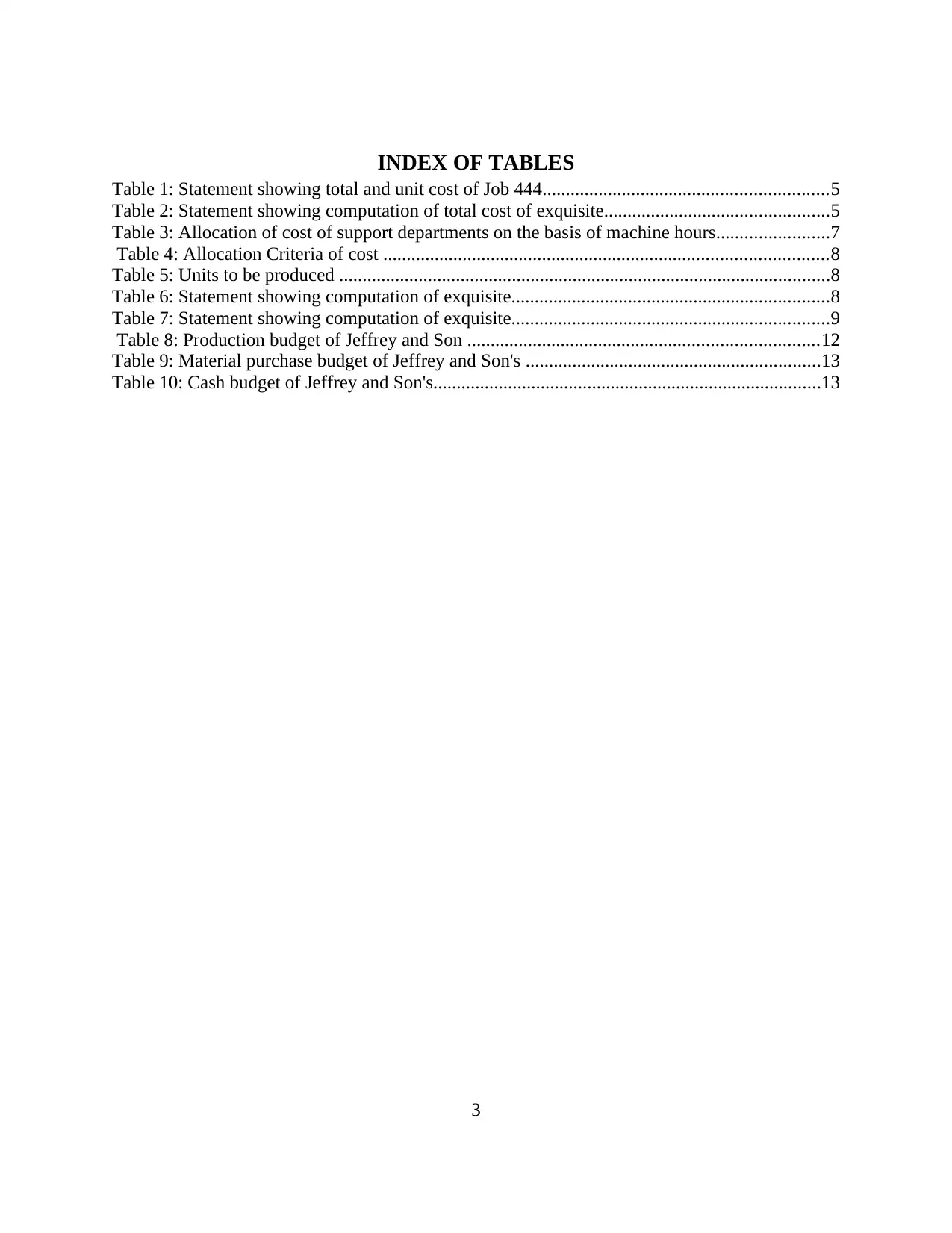
INDEX OF TABLES
Table 1: Statement showing total and unit cost of Job 444.............................................................5
Table 2: Statement showing computation of total cost of exquisite................................................5
Table 3: Allocation of cost of support departments on the basis of machine hours........................7
Table 4: Allocation Criteria of cost ...............................................................................................8
Table 5: Units to be produced .........................................................................................................8
Table 6: Statement showing computation of exquisite....................................................................8
Table 7: Statement showing computation of exquisite....................................................................9
Table 8: Production budget of Jeffrey and Son ...........................................................................12
Table 9: Material purchase budget of Jeffrey and Son's ...............................................................13
Table 10: Cash budget of Jeffrey and Son's...................................................................................13
3
Table 1: Statement showing total and unit cost of Job 444.............................................................5
Table 2: Statement showing computation of total cost of exquisite................................................5
Table 3: Allocation of cost of support departments on the basis of machine hours........................7
Table 4: Allocation Criteria of cost ...............................................................................................8
Table 5: Units to be produced .........................................................................................................8
Table 6: Statement showing computation of exquisite....................................................................8
Table 7: Statement showing computation of exquisite....................................................................9
Table 8: Production budget of Jeffrey and Son ...........................................................................12
Table 9: Material purchase budget of Jeffrey and Son's ...............................................................13
Table 10: Cash budget of Jeffrey and Son's...................................................................................13
3
⊘ This is a preview!⊘
Do you want full access?
Subscribe today to unlock all pages.

Trusted by 1+ million students worldwide

INTRODUCTION
Management accounting is used in business to provide accurate and reliable information
to the managers so they can make viable decisions for their growth and success. Approaches of
management accounting consists of strategic, performance and risk management (Burns and et.
al, 2004). Present report foucues on case study of Jeffrey and Sons Ltd. In this report description
will be provided regarding theoretical and practical application of various costing approaches by
considering information of provided business. Further, cost report will be prepared in order to
provide recommendations to the company for resolving current issues by making improvement
in their operational strategies.
TASK 1
1.1 Classification of different types of cost
Cost can be defined as expenses incurred by business in order to attain an economic
benefit for business. In a business, cost can be bifurcated on the basis of following aspects: On the basis of element: According to the factor of element, cost can be segregated in
direct and indirect cost. Direct cost is incurred for the production activities while indirect
cost is incurred for attaining value added benefits (Jiambalvo, 2001). Example of direct
cost is raw material and labour and of indirect cost is rent and lightning expense. On the basis of function: Cost can also be bifurcated as per functional activities of a
business organization. General classification of the cost on the basis of function are
administration, distribution, production, advertising, research and development and
selling. On the basis of nature: As per the nature, cost can be classified into material, labour and
expenditure of overhead. Material expenses are incurred for the purchase of goods
required for production activities (Keown, 2005). Labour cost is incurred for the payment
of wages and salaries to the employees for services provided by them.
On the basis of behaviour: By considering behaviour as a factor, cost can be bifurcated
into fixed, variable and semi-variable cost. Fixed cost are those expenses which does not
alter with the change in production units (Kont, 2013). Example of fixed cost is salary,
rent and depreciation. Variable cost is just opposite to the fixed cost as it is in direct
4
Management accounting is used in business to provide accurate and reliable information
to the managers so they can make viable decisions for their growth and success. Approaches of
management accounting consists of strategic, performance and risk management (Burns and et.
al, 2004). Present report foucues on case study of Jeffrey and Sons Ltd. In this report description
will be provided regarding theoretical and practical application of various costing approaches by
considering information of provided business. Further, cost report will be prepared in order to
provide recommendations to the company for resolving current issues by making improvement
in their operational strategies.
TASK 1
1.1 Classification of different types of cost
Cost can be defined as expenses incurred by business in order to attain an economic
benefit for business. In a business, cost can be bifurcated on the basis of following aspects: On the basis of element: According to the factor of element, cost can be segregated in
direct and indirect cost. Direct cost is incurred for the production activities while indirect
cost is incurred for attaining value added benefits (Jiambalvo, 2001). Example of direct
cost is raw material and labour and of indirect cost is rent and lightning expense. On the basis of function: Cost can also be bifurcated as per functional activities of a
business organization. General classification of the cost on the basis of function are
administration, distribution, production, advertising, research and development and
selling. On the basis of nature: As per the nature, cost can be classified into material, labour and
expenditure of overhead. Material expenses are incurred for the purchase of goods
required for production activities (Keown, 2005). Labour cost is incurred for the payment
of wages and salaries to the employees for services provided by them.
On the basis of behaviour: By considering behaviour as a factor, cost can be bifurcated
into fixed, variable and semi-variable cost. Fixed cost are those expenses which does not
alter with the change in production units (Kont, 2013). Example of fixed cost is salary,
rent and depreciation. Variable cost is just opposite to the fixed cost as it is in direct
4
Paraphrase This Document
Need a fresh take? Get an instant paraphrase of this document with our AI Paraphraser
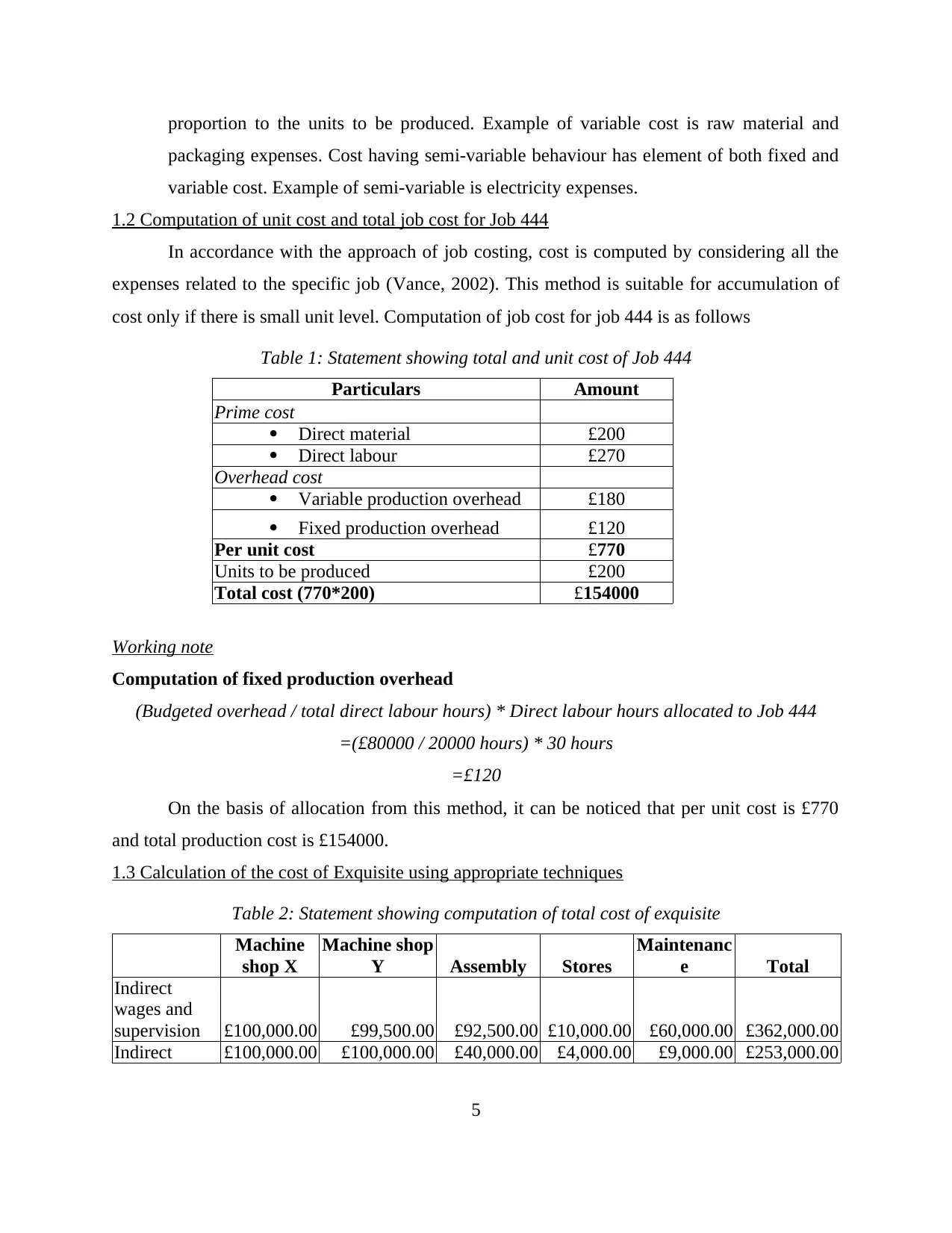
proportion to the units to be produced. Example of variable cost is raw material and
packaging expenses. Cost having semi-variable behaviour has element of both fixed and
variable cost. Example of semi-variable is electricity expenses.
1.2 Computation of unit cost and total job cost for Job 444
In accordance with the approach of job costing, cost is computed by considering all the
expenses related to the specific job (Vance, 2002). This method is suitable for accumulation of
cost only if there is small unit level. Computation of job cost for job 444 is as follows
Table 1: Statement showing total and unit cost of Job 444
Particulars Amount
Prime cost
Direct material £200
Direct labour £270
Overhead cost
Variable production overhead £180
Fixed production overhead £120
Per unit cost £770
Units to be produced £200
Total cost (770*200) £154000
Working note
Computation of fixed production overhead
(Budgeted overhead / total direct labour hours) * Direct labour hours allocated to Job 444
=(£80000 / 20000 hours) * 30 hours
=£120
On the basis of allocation from this method, it can be noticed that per unit cost is £770
and total production cost is £154000.
1.3 Calculation of the cost of Exquisite using appropriate techniques
Table 2: Statement showing computation of total cost of exquisite
Machine
shop X
Machine shop
Y Assembly Stores
Maintenanc
e Total
Indirect
wages and
supervision £100,000.00 £99,500.00 £92,500.00 £10,000.00 £60,000.00 £362,000.00
Indirect £100,000.00 £100,000.00 £40,000.00 £4,000.00 £9,000.00 £253,000.00
5
packaging expenses. Cost having semi-variable behaviour has element of both fixed and
variable cost. Example of semi-variable is electricity expenses.
1.2 Computation of unit cost and total job cost for Job 444
In accordance with the approach of job costing, cost is computed by considering all the
expenses related to the specific job (Vance, 2002). This method is suitable for accumulation of
cost only if there is small unit level. Computation of job cost for job 444 is as follows
Table 1: Statement showing total and unit cost of Job 444
Particulars Amount
Prime cost
Direct material £200
Direct labour £270
Overhead cost
Variable production overhead £180
Fixed production overhead £120
Per unit cost £770
Units to be produced £200
Total cost (770*200) £154000
Working note
Computation of fixed production overhead
(Budgeted overhead / total direct labour hours) * Direct labour hours allocated to Job 444
=(£80000 / 20000 hours) * 30 hours
=£120
On the basis of allocation from this method, it can be noticed that per unit cost is £770
and total production cost is £154000.
1.3 Calculation of the cost of Exquisite using appropriate techniques
Table 2: Statement showing computation of total cost of exquisite
Machine
shop X
Machine shop
Y Assembly Stores
Maintenanc
e Total
Indirect
wages and
supervision £100,000.00 £99,500.00 £92,500.00 £10,000.00 £60,000.00 £362,000.00
Indirect £100,000.00 £100,000.00 £40,000.00 £4,000.00 £9,000.00 £253,000.00
5
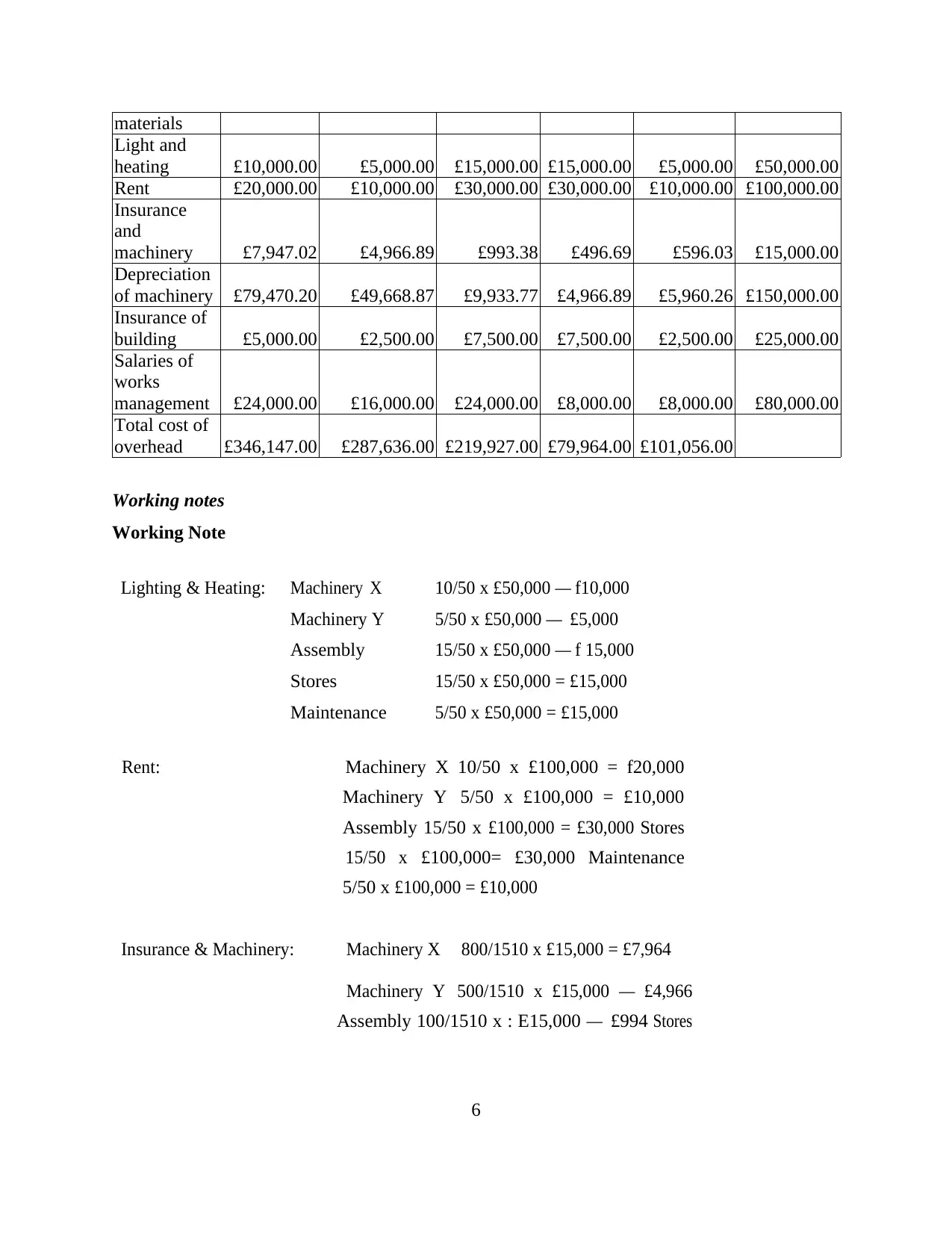
materials
Light and
heating £10,000.00 £5,000.00 £15,000.00 £15,000.00 £5,000.00 £50,000.00
Rent £20,000.00 £10,000.00 £30,000.00 £30,000.00 £10,000.00 £100,000.00
Insurance
and
machinery £7,947.02 £4,966.89 £993.38 £496.69 £596.03 £15,000.00
Depreciation
of machinery £79,470.20 £49,668.87 £9,933.77 £4,966.89 £5,960.26 £150,000.00
Insurance of
building £5,000.00 £2,500.00 £7,500.00 £7,500.00 £2,500.00 £25,000.00
Salaries of
works
management £24,000.00 £16,000.00 £24,000.00 £8,000.00 £8,000.00 £80,000.00
Total cost of
overhead £346,147.00 £287,636.00 £219,927.00 £79,964.00 £101,056.00
Working notes
Working Note
Lighting & Heating: Machinery X 10/50 x £50,000 — f10,000
Machinery Y 5/50 x £50,000 — £5,000
Assembly 15/50 x £50,000 — f 15,000
Stores 15/50 x £50,000 = £15,000
Maintenance 5/50 x £50,000 = £15,000
Rent: Machinery X 10/50 x £100,000 = f20,000
Machinery Y 5/50 x £100,000 = £10,000
Assembly 15/50 x £100,000 = £30,000 Stores
15/50 x £100,000= £30,000 Maintenance
5/50 x £100,000 = £10,000
Insurance & Machinery: Machinery X 800/1510 x £15,000 = £7,964
Machinery Y 500/1510 x £15,000 — £4,966
Assembly 100/1510 x : E15,000 — £994 Stores
6
Light and
heating £10,000.00 £5,000.00 £15,000.00 £15,000.00 £5,000.00 £50,000.00
Rent £20,000.00 £10,000.00 £30,000.00 £30,000.00 £10,000.00 £100,000.00
Insurance
and
machinery £7,947.02 £4,966.89 £993.38 £496.69 £596.03 £15,000.00
Depreciation
of machinery £79,470.20 £49,668.87 £9,933.77 £4,966.89 £5,960.26 £150,000.00
Insurance of
building £5,000.00 £2,500.00 £7,500.00 £7,500.00 £2,500.00 £25,000.00
Salaries of
works
management £24,000.00 £16,000.00 £24,000.00 £8,000.00 £8,000.00 £80,000.00
Total cost of
overhead £346,147.00 £287,636.00 £219,927.00 £79,964.00 £101,056.00
Working notes
Working Note
Lighting & Heating: Machinery X 10/50 x £50,000 — f10,000
Machinery Y 5/50 x £50,000 — £5,000
Assembly 15/50 x £50,000 — f 15,000
Stores 15/50 x £50,000 = £15,000
Maintenance 5/50 x £50,000 = £15,000
Rent: Machinery X 10/50 x £100,000 = f20,000
Machinery Y 5/50 x £100,000 = £10,000
Assembly 15/50 x £100,000 = £30,000 Stores
15/50 x £100,000= £30,000 Maintenance
5/50 x £100,000 = £10,000
Insurance & Machinery: Machinery X 800/1510 x £15,000 = £7,964
Machinery Y 500/1510 x £15,000 — £4,966
Assembly 100/1510 x : E15,000 — £994 Stores
6
⊘ This is a preview!⊘
Do you want full access?
Subscribe today to unlock all pages.

Trusted by 1+ million students worldwide
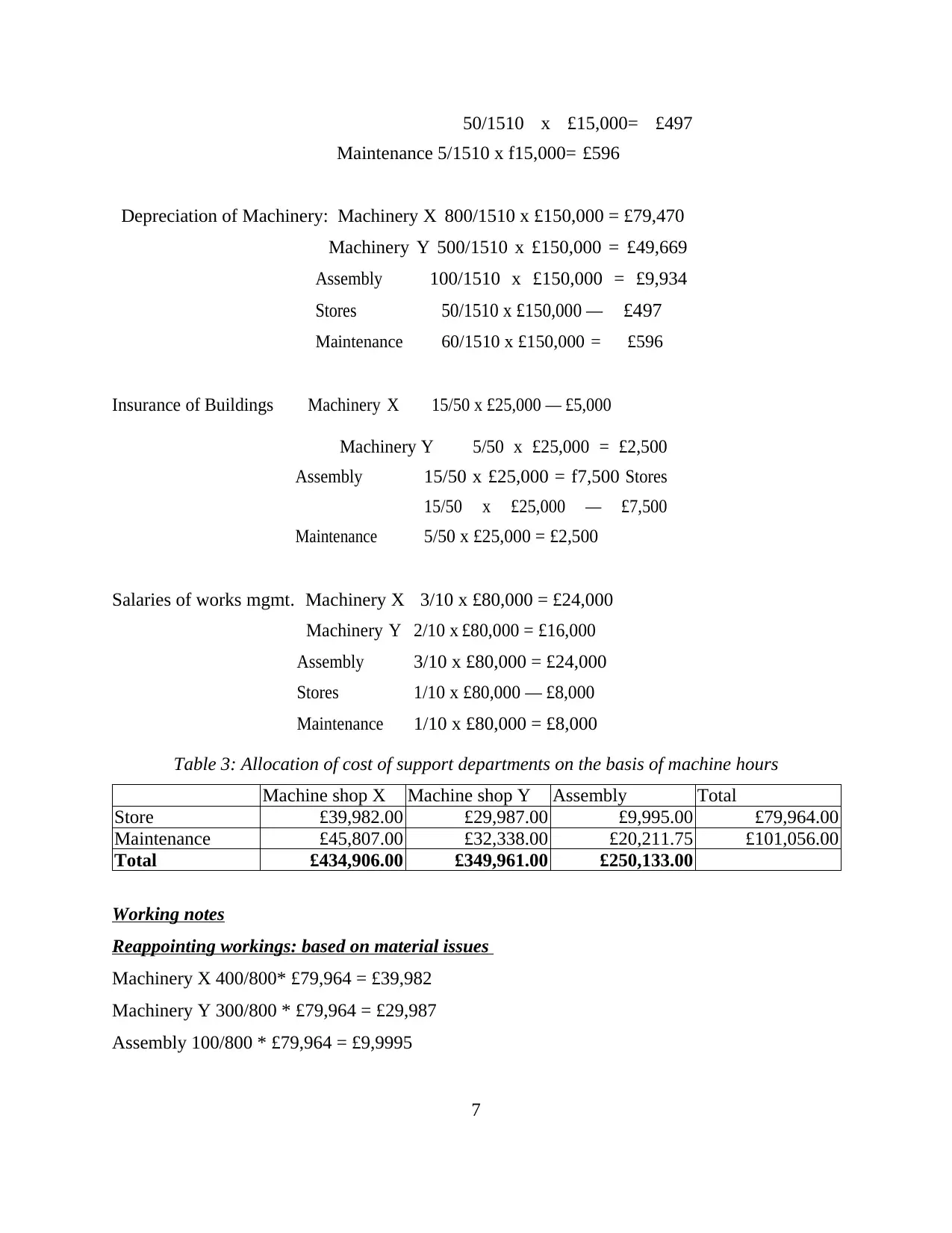
50/1510 x £15,000= £497
Maintenance 5/1510 x f15,000= £596
Depreciation of Machinery: Machinery X 800/1510 x £150,000 = £79,470
Machinery Y 500/1510 x £150,000 = £49,669
Assembly 100/1510 x £150,000 = £9,934
Stores 50/1510 x £150,000 — £497
Maintenance 60/1510 x £150,000 = £596
Insurance of Buildings Machinery X 15/50 x £25,000 — £5,000
Machinery Y 5/50 x £25,000 = £2,500
Assembly 15/50 x £25,000 = f7,500 Stores
15/50 x £25,000 — £7,500
Maintenance 5/50 x £25,000 = £2,500
Salaries of works mgmt. Machinery X 3/10 x £80,000 = £24,000
Machinery Y 2/10 x £80,000 = £16,000
Assembly 3/10 x £80,000 = £24,000
Stores 1/10 x £80,000 — £8,000
Maintenance 1/10 x £80,000 = £8,000
Table 3: Allocation of cost of support departments on the basis of machine hours
Machine shop X Machine shop Y Assembly Total
Store £39,982.00 £29,987.00 £9,995.00 £79,964.00
Maintenance £45,807.00 £32,338.00 £20,211.75 £101,056.00
Total £434,906.00 £349,961.00 £250,133.00
Working notes
Reappointing workings: based on material issues
Machinery X 400/800* £79,964 = £39,982
Machinery Y 300/800 * £79,964 = £29,987
Assembly 100/800 * £79,964 = £9,9995
7
Maintenance 5/1510 x f15,000= £596
Depreciation of Machinery: Machinery X 800/1510 x £150,000 = £79,470
Machinery Y 500/1510 x £150,000 = £49,669
Assembly 100/1510 x £150,000 = £9,934
Stores 50/1510 x £150,000 — £497
Maintenance 60/1510 x £150,000 = £596
Insurance of Buildings Machinery X 15/50 x £25,000 — £5,000
Machinery Y 5/50 x £25,000 = £2,500
Assembly 15/50 x £25,000 = f7,500 Stores
15/50 x £25,000 — £7,500
Maintenance 5/50 x £25,000 = £2,500
Salaries of works mgmt. Machinery X 3/10 x £80,000 = £24,000
Machinery Y 2/10 x £80,000 = £16,000
Assembly 3/10 x £80,000 = £24,000
Stores 1/10 x £80,000 — £8,000
Maintenance 1/10 x £80,000 = £8,000
Table 3: Allocation of cost of support departments on the basis of machine hours
Machine shop X Machine shop Y Assembly Total
Store £39,982.00 £29,987.00 £9,995.00 £79,964.00
Maintenance £45,807.00 £32,338.00 £20,211.75 £101,056.00
Total £434,906.00 £349,961.00 £250,133.00
Working notes
Reappointing workings: based on material issues
Machinery X 400/800* £79,964 = £39,982
Machinery Y 300/800 * £79,964 = £29,987
Assembly 100/800 * £79,964 = £9,9995
7
Paraphrase This Document
Need a fresh take? Get an instant paraphrase of this document with our AI Paraphraser
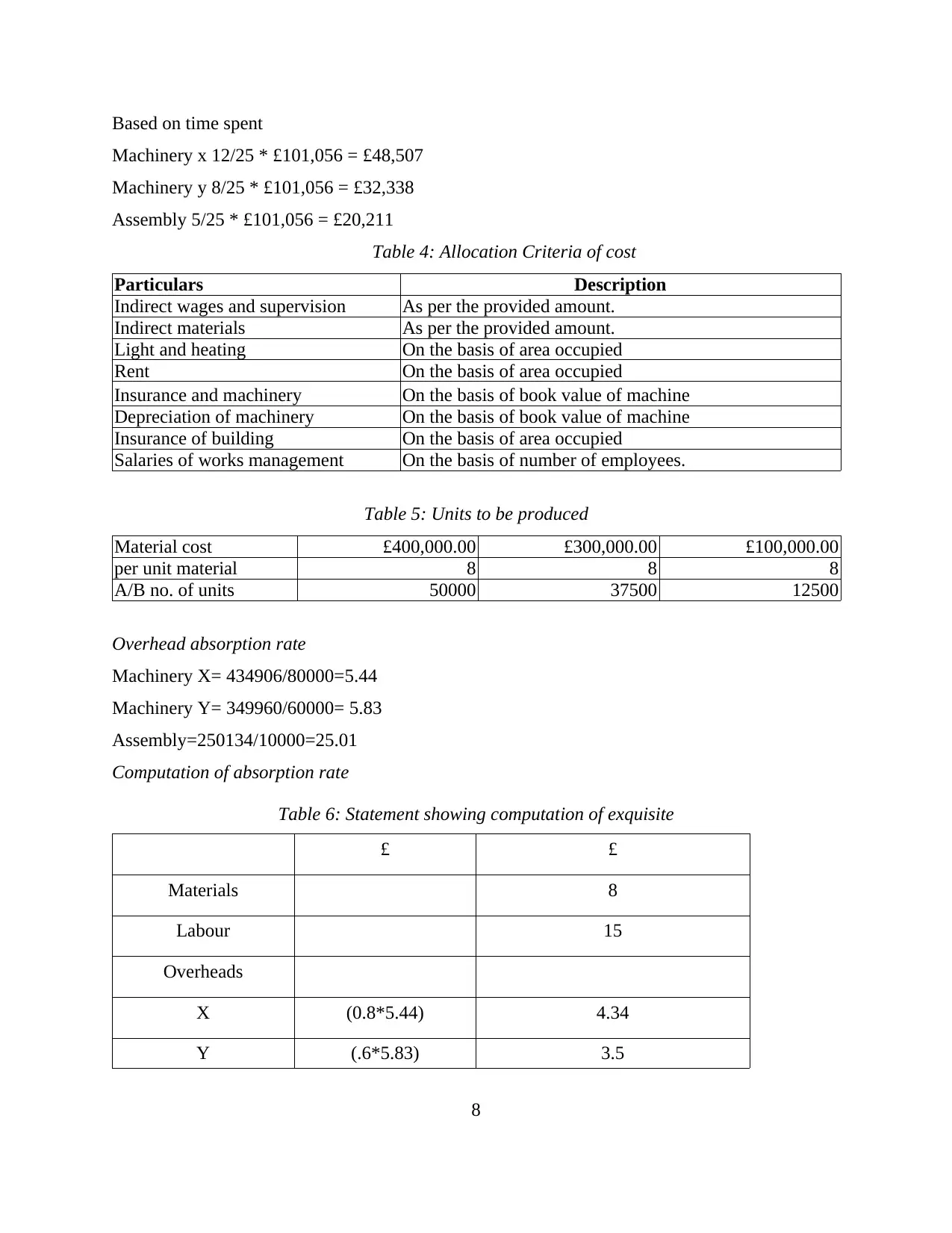
Based on time spent
Machinery x 12/25 * £101,056 = £48,507
Machinery y 8/25 * £101,056 = £32,338
Assembly 5/25 * £101,056 = £20,211
Table 4: Allocation Criteria of cost
Particulars Description
Indirect wages and supervision As per the provided amount.
Indirect materials As per the provided amount.
Light and heating On the basis of area occupied
Rent On the basis of area occupied
Insurance and machinery On the basis of book value of machine
Depreciation of machinery On the basis of book value of machine
Insurance of building On the basis of area occupied
Salaries of works management On the basis of number of employees.
Table 5: Units to be produced
Material cost £400,000.00 £300,000.00 £100,000.00
per unit material 8 8 8
A/B no. of units 50000 37500 12500
Overhead absorption rate
Machinery X= 434906/80000=5.44
Machinery Y= 349960/60000= 5.83
Assembly=250134/10000=25.01
Computation of absorption rate
Table 6: Statement showing computation of exquisite
£ £
Materials 8
Labour 15
Overheads
X (0.8*5.44) 4.34
Y (.6*5.83) 3.5
8
Machinery x 12/25 * £101,056 = £48,507
Machinery y 8/25 * £101,056 = £32,338
Assembly 5/25 * £101,056 = £20,211
Table 4: Allocation Criteria of cost
Particulars Description
Indirect wages and supervision As per the provided amount.
Indirect materials As per the provided amount.
Light and heating On the basis of area occupied
Rent On the basis of area occupied
Insurance and machinery On the basis of book value of machine
Depreciation of machinery On the basis of book value of machine
Insurance of building On the basis of area occupied
Salaries of works management On the basis of number of employees.
Table 5: Units to be produced
Material cost £400,000.00 £300,000.00 £100,000.00
per unit material 8 8 8
A/B no. of units 50000 37500 12500
Overhead absorption rate
Machinery X= 434906/80000=5.44
Machinery Y= 349960/60000= 5.83
Assembly=250134/10000=25.01
Computation of absorption rate
Table 6: Statement showing computation of exquisite
£ £
Materials 8
Labour 15
Overheads
X (0.8*5.44) 4.34
Y (.6*5.83) 3.5
8

Assembly (.1*25.01) 2.5
Total cost 33.35
1.4 Analysis of cost data of exquisite using appropriate techniques
Overhead absorption rate on the basis of labour hours
Machinery X= 434908/200000= 2.17
Machinery Y= 349960/150000= 2.33
Assembly=250134/20000= 2.15
Table 7: Statement showing computation of exquisite
£ £
Materials 8
Labour 15
Overheads
X (2*2.17) 4.34
Y (1.5*2.33) 3.5
Assembly (1*1.25) 1.25
Total cost 32.09
By considering alteration in the overhead absorption rate from machine hour to labour
hour, it can be said that there is a significant reduction in per unit rate. In accordance with the
costing principles, absorption on the basis of labour hours is more feasible approach (Youseef,
2013). By considering this aspect, management is required to make decision of cost on the basis
of this approach.
9
Total cost 33.35
1.4 Analysis of cost data of exquisite using appropriate techniques
Overhead absorption rate on the basis of labour hours
Machinery X= 434908/200000= 2.17
Machinery Y= 349960/150000= 2.33
Assembly=250134/20000= 2.15
Table 7: Statement showing computation of exquisite
£ £
Materials 8
Labour 15
Overheads
X (2*2.17) 4.34
Y (1.5*2.33) 3.5
Assembly (1*1.25) 1.25
Total cost 32.09
By considering alteration in the overhead absorption rate from machine hour to labour
hour, it can be said that there is a significant reduction in per unit rate. In accordance with the
costing principles, absorption on the basis of labour hours is more feasible approach (Youseef,
2013). By considering this aspect, management is required to make decision of cost on the basis
of this approach.
9
⊘ This is a preview!⊘
Do you want full access?
Subscribe today to unlock all pages.

Trusted by 1+ million students worldwide

TASK 2
2.1 Preparation and analysis of the cost report for the month of September
Cost report of September month
Budgeted cost Actual cost Variances
Particulars
Units 2000 units 1900 units
Material cost 24000 22800 1200 F
Labour cost 18000 19000 1000 A
Fixed overhead 15000 15000 -
Prime cost 57000 56800 -
Electricity
Fixed portion 500 500 -
Variable portion 7500 7125 375 F
Maintenance 5000 5000 -
Total production cost 70000 69425
Working notes
Calculation of standard budget at 1900 units
Budgeted cost Standard cost
Particulars
Units 2000 units 1900 units
Material cost 24000 22800
Labour cost 18000 17100
Fixed overhead 15000 15000
Prime cost 57000 54900
Electricity
Fixed portion 500 500
Variable portion 7500 7125
Maintenance 5000 5000
10
2.1 Preparation and analysis of the cost report for the month of September
Cost report of September month
Budgeted cost Actual cost Variances
Particulars
Units 2000 units 1900 units
Material cost 24000 22800 1200 F
Labour cost 18000 19000 1000 A
Fixed overhead 15000 15000 -
Prime cost 57000 56800 -
Electricity
Fixed portion 500 500 -
Variable portion 7500 7125 375 F
Maintenance 5000 5000 -
Total production cost 70000 69425
Working notes
Calculation of standard budget at 1900 units
Budgeted cost Standard cost
Particulars
Units 2000 units 1900 units
Material cost 24000 22800
Labour cost 18000 17100
Fixed overhead 15000 15000
Prime cost 57000 54900
Electricity
Fixed portion 500 500
Variable portion 7500 7125
Maintenance 5000 5000
10
Paraphrase This Document
Need a fresh take? Get an instant paraphrase of this document with our AI Paraphraser
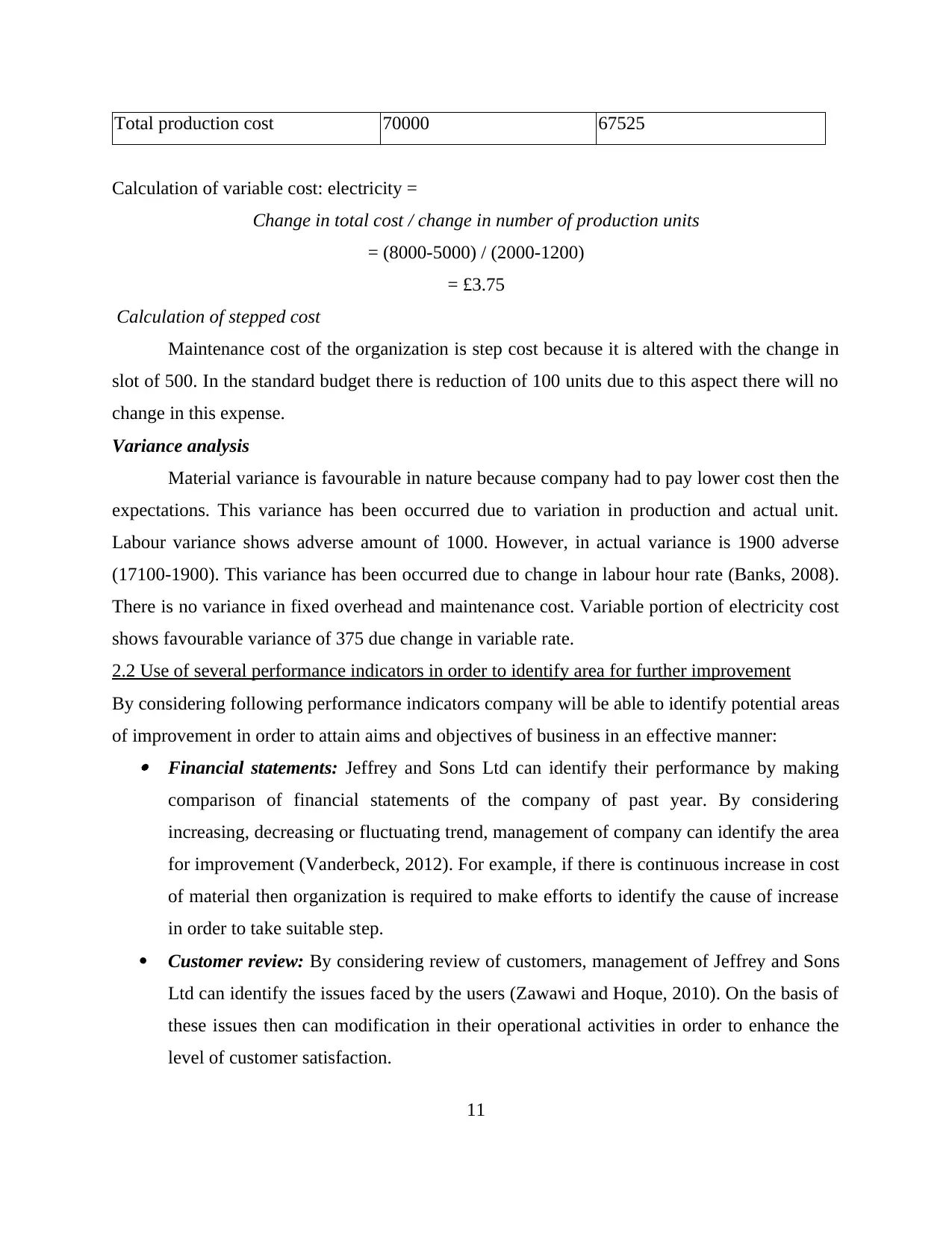
Total production cost 70000 67525
Calculation of variable cost: electricity =
Change in total cost / change in number of production units
= (8000-5000) / (2000-1200)
= £3.75
Calculation of stepped cost
Maintenance cost of the organization is step cost because it is altered with the change in
slot of 500. In the standard budget there is reduction of 100 units due to this aspect there will no
change in this expense.
Variance analysis
Material variance is favourable in nature because company had to pay lower cost then the
expectations. This variance has been occurred due to variation in production and actual unit.
Labour variance shows adverse amount of 1000. However, in actual variance is 1900 adverse
(17100-1900). This variance has been occurred due to change in labour hour rate (Banks, 2008).
There is no variance in fixed overhead and maintenance cost. Variable portion of electricity cost
shows favourable variance of 375 due change in variable rate.
2.2 Use of several performance indicators in order to identify area for further improvement
By considering following performance indicators company will be able to identify potential areas
of improvement in order to attain aims and objectives of business in an effective manner: Financial statements: Jeffrey and Sons Ltd can identify their performance by making
comparison of financial statements of the company of past year. By considering
increasing, decreasing or fluctuating trend, management of company can identify the area
for improvement (Vanderbeck, 2012). For example, if there is continuous increase in cost
of material then organization is required to make efforts to identify the cause of increase
in order to take suitable step.
Customer review: By considering review of customers, management of Jeffrey and Sons
Ltd can identify the issues faced by the users (Zawawi and Hoque, 2010). On the basis of
these issues then can modification in their operational activities in order to enhance the
level of customer satisfaction.
11
Calculation of variable cost: electricity =
Change in total cost / change in number of production units
= (8000-5000) / (2000-1200)
= £3.75
Calculation of stepped cost
Maintenance cost of the organization is step cost because it is altered with the change in
slot of 500. In the standard budget there is reduction of 100 units due to this aspect there will no
change in this expense.
Variance analysis
Material variance is favourable in nature because company had to pay lower cost then the
expectations. This variance has been occurred due to variation in production and actual unit.
Labour variance shows adverse amount of 1000. However, in actual variance is 1900 adverse
(17100-1900). This variance has been occurred due to change in labour hour rate (Banks, 2008).
There is no variance in fixed overhead and maintenance cost. Variable portion of electricity cost
shows favourable variance of 375 due change in variable rate.
2.2 Use of several performance indicators in order to identify area for further improvement
By considering following performance indicators company will be able to identify potential areas
of improvement in order to attain aims and objectives of business in an effective manner: Financial statements: Jeffrey and Sons Ltd can identify their performance by making
comparison of financial statements of the company of past year. By considering
increasing, decreasing or fluctuating trend, management of company can identify the area
for improvement (Vanderbeck, 2012). For example, if there is continuous increase in cost
of material then organization is required to make efforts to identify the cause of increase
in order to take suitable step.
Customer review: By considering review of customers, management of Jeffrey and Sons
Ltd can identify the issues faced by the users (Zawawi and Hoque, 2010). On the basis of
these issues then can modification in their operational activities in order to enhance the
level of customer satisfaction.
11
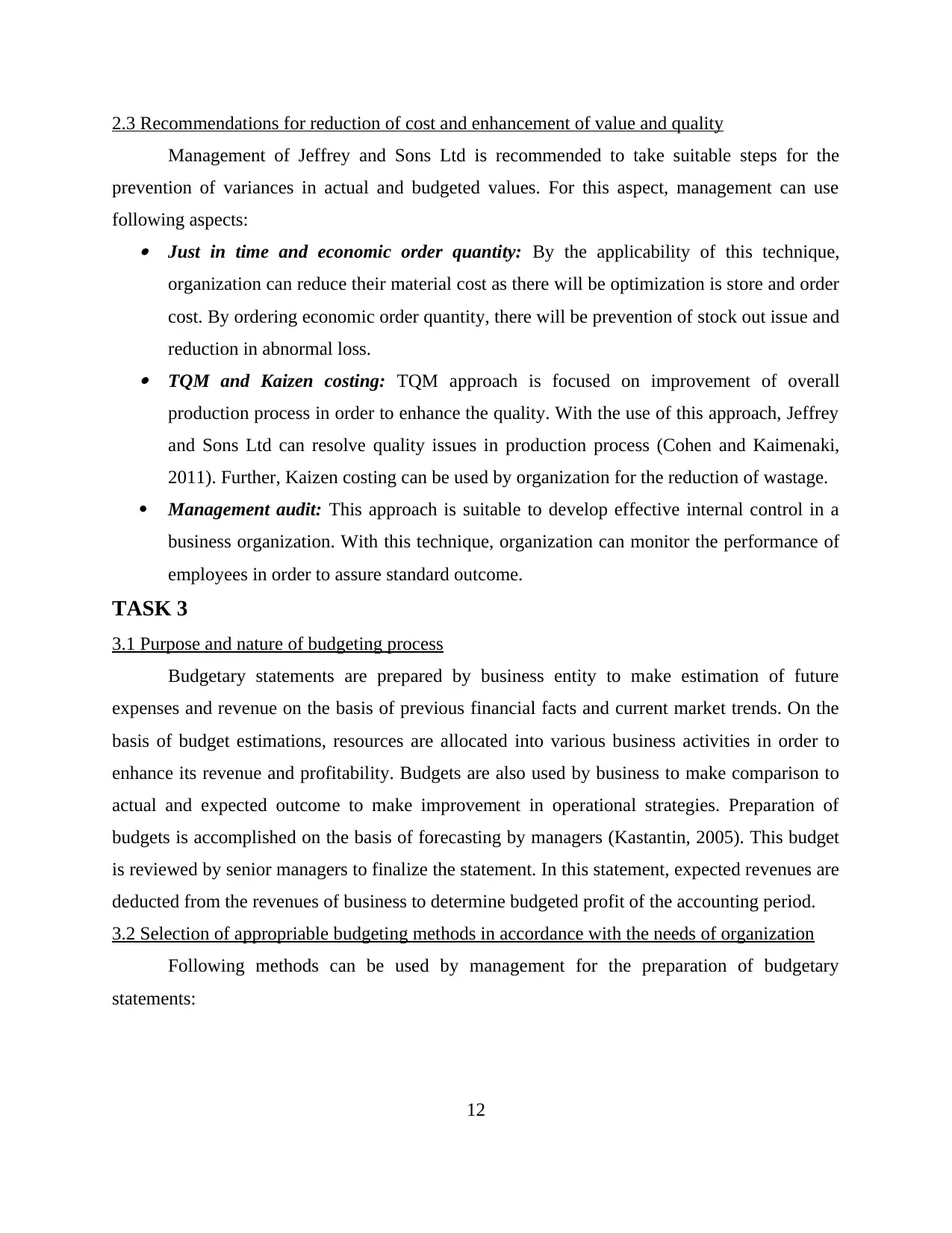
2.3 Recommendations for reduction of cost and enhancement of value and quality
Management of Jeffrey and Sons Ltd is recommended to take suitable steps for the
prevention of variances in actual and budgeted values. For this aspect, management can use
following aspects: Just in time and economic order quantity: By the applicability of this technique,
organization can reduce their material cost as there will be optimization is store and order
cost. By ordering economic order quantity, there will be prevention of stock out issue and
reduction in abnormal loss. TQM and Kaizen costing: TQM approach is focused on improvement of overall
production process in order to enhance the quality. With the use of this approach, Jeffrey
and Sons Ltd can resolve quality issues in production process (Cohen and Kaimenaki,
2011). Further, Kaizen costing can be used by organization for the reduction of wastage.
Management audit: This approach is suitable to develop effective internal control in a
business organization. With this technique, organization can monitor the performance of
employees in order to assure standard outcome.
TASK 3
3.1 Purpose and nature of budgeting process
Budgetary statements are prepared by business entity to make estimation of future
expenses and revenue on the basis of previous financial facts and current market trends. On the
basis of budget estimations, resources are allocated into various business activities in order to
enhance its revenue and profitability. Budgets are also used by business to make comparison to
actual and expected outcome to make improvement in operational strategies. Preparation of
budgets is accomplished on the basis of forecasting by managers (Kastantin, 2005). This budget
is reviewed by senior managers to finalize the statement. In this statement, expected revenues are
deducted from the revenues of business to determine budgeted profit of the accounting period.
3.2 Selection of appropriable budgeting methods in accordance with the needs of organization
Following methods can be used by management for the preparation of budgetary
statements:
12
Management of Jeffrey and Sons Ltd is recommended to take suitable steps for the
prevention of variances in actual and budgeted values. For this aspect, management can use
following aspects: Just in time and economic order quantity: By the applicability of this technique,
organization can reduce their material cost as there will be optimization is store and order
cost. By ordering economic order quantity, there will be prevention of stock out issue and
reduction in abnormal loss. TQM and Kaizen costing: TQM approach is focused on improvement of overall
production process in order to enhance the quality. With the use of this approach, Jeffrey
and Sons Ltd can resolve quality issues in production process (Cohen and Kaimenaki,
2011). Further, Kaizen costing can be used by organization for the reduction of wastage.
Management audit: This approach is suitable to develop effective internal control in a
business organization. With this technique, organization can monitor the performance of
employees in order to assure standard outcome.
TASK 3
3.1 Purpose and nature of budgeting process
Budgetary statements are prepared by business entity to make estimation of future
expenses and revenue on the basis of previous financial facts and current market trends. On the
basis of budget estimations, resources are allocated into various business activities in order to
enhance its revenue and profitability. Budgets are also used by business to make comparison to
actual and expected outcome to make improvement in operational strategies. Preparation of
budgets is accomplished on the basis of forecasting by managers (Kastantin, 2005). This budget
is reviewed by senior managers to finalize the statement. In this statement, expected revenues are
deducted from the revenues of business to determine budgeted profit of the accounting period.
3.2 Selection of appropriable budgeting methods in accordance with the needs of organization
Following methods can be used by management for the preparation of budgetary
statements:
12
⊘ This is a preview!⊘
Do you want full access?
Subscribe today to unlock all pages.

Trusted by 1+ million students worldwide
1 out of 20
Related Documents
Your All-in-One AI-Powered Toolkit for Academic Success.
+13062052269
info@desklib.com
Available 24*7 on WhatsApp / Email
![[object Object]](/_next/static/media/star-bottom.7253800d.svg)
Unlock your academic potential
Copyright © 2020–2025 A2Z Services. All Rights Reserved. Developed and managed by ZUCOL.





